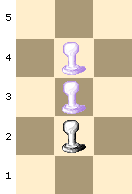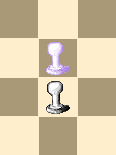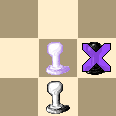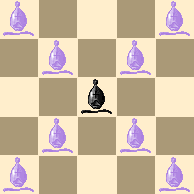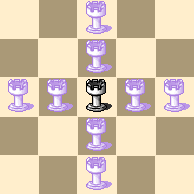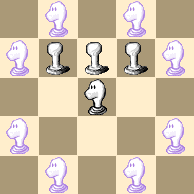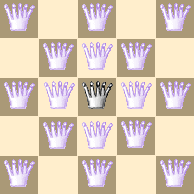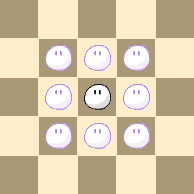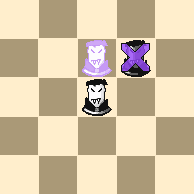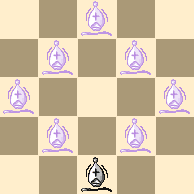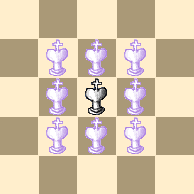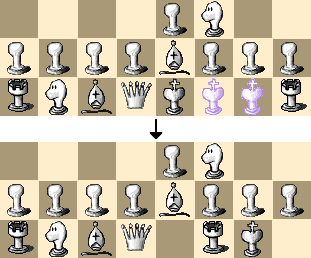 SICO is one of the snoot.org toys, a bizarre variation on the classic game of chess in which people from all over the internet take turns playing moves. There's no real winner or loser, and you need only commit the time to play a single move before taking off. It's chess for generation XI! This page explains how to play SICO, and also includes a brief tutorial on chess and a tiny FAQ. If you don't think you need instructions, just go to the game! Game Menu On the main menu is a list of games that are currently running. When someone is playing a game, it will show up as "locked", which means that you can't play until that person is done or until the player's lock times out from inactivity. If you've just played in one of the games, it will be greyed out, since you are not allowed to make two moves in a row. Otherwise, you can click on the game number in order to start play. (No matter the status of the game, you can always click on the [see] link to peek at the game without playing.) If any games have ended in the last 12 hours or so, they will show up under "Recently Completed Games", and you can click on those links to see how they looked when they ended (as well as all the moves played and comments made). You can also make post-game commentary from this screen. Older completed games are stored in the archive. Inside a game, you'll be presented with a chessboard. Before making your move you might want to make a comment; you can do this by simply typing in the box and clicking the "comment" button. (After you make your move, you won't be able to access the game again, so make your comments first.) If you think that the game is a draw, or if it has started out in one of the unpopular variations, you might want to offer or accept a draw. The button to offer a draw looks like this:
If someone else has offered a draw, it will look like this:
It takes several acceptances from different people for a draw offer to go through. If the game truly is hopless, or it is at the beginning of a variation that is unpopular, it's a good idea to accept the draw. However, SICO etiquette suggests playing a game to its bitter end if one side can win. (Strangely, mate is often quicker and easier to reach than consensus!) You can click on the "go back" link to go back to the main menu. This is superior to the "back" function in your browser since it makes the game immediately playable by others. Otherwise, you should click on one of your pieces. (Under the board it says rather subtly whose turn it is.) If the piece is not clickable, it means that it has no legal moves available, perhaps because your king is currently threatened. After clicking a piece, you should see several light purple destinations for that piece appear (and perhaps some purple Xs if that piece can capture opponent's pieces). Click on one of these spots to make the move, or click the button that looks like this:
To choose a different piece ("back" in your browser will not work). That's it! You can see the result of your handiwork, and then click the "sico" link at the top of the page to go back to the menu. Next I'll explain how the various pieces in SICO move around. Rules The rules of chess are somewhat complicated if you haven't played before. (If you haven't, it's worth reading this page and learning!) Fortunately, SICO will only let you make legal moves, and it even shows you what moves are possible at each step. (Of course, it won't keep you from making crummy moves, but hey, that's what SICO is all about!) If you know how to play chess, you may want to skip to the section called differences between SICO and standard chess. The game starts out in one of the many starting positions, and players take turn moving pieces until the game is over (either because the players agree on a draw, or because one player cannot make any moves). Moving can also involve capturing the opponent's pieces, in which case the piece is removed from play.
The pawn is the most common piece. A pawn typically moves one space forward (for white, this means towards the top of the screen, for black, the bottom). White pawns on the 2nd rank have the option of moving two spaces forward. (Black pawns do the same on the 7th rank). Pawns can only capture one space diagonally forward. Unlike standard chess, SICO does not have en passant capturing. When a pawn gets all the way to the end of the board, the owner gets the choice of turning it into any piece he wants. (Typically a queen, though a knight can be more useful in some endgame situations.) When this happens, a menu will appear that lets you choose the piece you want to promote to.
A bishop moves and captures diagonally. A bishop is born on a particular color, and since he travels diagonally, can never leave it.
A rook moves and captures in a straight line along a row or column.
A knight moves and captures in an L-shape; two spaces in one direction and then one in the other. A knight is the only piece that can jump over other pieces of the same or opposite color. Note that the knight always jumps to a square of the opposite color of the one it's on.
A queen can move and capture like a bishop or rook (diagonally or straight). It's cute that on a 5x5 grid, the only places it can't get to are exactly the places that a knight can.
A Kirby can move one space in any direction, but can't capture pieces. Nothing can capture a Kirby, either. However, if all of one side's pieces are captured (except for Kirbies, walls, and the King), then all Kirbies die and can't be moved for the rest of the game. Kirby is not a standard chess piece; he can be found in some of the variations.
Vampires move just like pawns, with one difference: When they capture an enemy piece, they turn into that type of piece. (So if you capture the enemy queen, you become a queen.) Vampires aren't standard chess pieces, but can be found in some of the variations.
The bounceshop moves like a bishop but can reflect off the edges of the board as many times as he likes. On an open board, the bounceshop can cover almost every square of his color. Bounceshops are not standard chess pieces, but they can be found in some of the variations.
The king moves and captures one space in any direction. The king has one special move, known as castling. When the rook (or whatever piece begins in the corner, in one of the variations) and king have not yet moved, and all of the spaces between them are clear, the king can move two spaces towards the corner and the rook can jump over him. This is shown in the picture below:
Castling is performed by selecting the king and moving to the farther spot. You can also castle on the other side (a "long" or "queen-side" castle) in a similar way. Unlike chess, SICO allows you to castle out of, or through check (see below). There is an additional restriction on all moves: You cannot make a move that leaves your king open to attack ("in check"). So, if the opponent has threatened your king, you must defend him on the next move. If you can make no moves, and your king is in check, then you lose. If you can make no moves, and your king is not in check, then the game is a tie -- so if you are in a losing situation, sometimes it is possible to force or trick your opponent into a draw this way! Differences between SICO and standard chess I have modified the chess "algebra" (notation for recording a game) slightly, though this should be easy to pick up. Pawns cannot capture en passant. The king can castle with any piece, not just a rook (this only applies to games where the starting position is different, since a piece cannot assist with castling once it has moved). More importantly, the king can castle out of, or through, check. There are several new starting positions and pieces. (See above or the variations page.) Rules about repeated positions, automatic draws, time limits, etc. do not apply. And of course, a game is not limited to two players!
Occasionally Asked Questions and Their Answers What does SICO stand for? On the old snoot.com site, SICO stood for Schizophrenic Internet Chess Online. Since schizophrenia actually has nothing to do with the sense I was trying to convey (despite popular belief), SICO now officially stands for Snoot Internet Chess Orgy, though I think plain ol' SICO is easier to say. People keep making stupid ass moves and ruining everything! What the hell! That's what SICO is about! Think of it like a bunch of cheat-proof chessboards and un-stealable pieces in the park with lots of people around playing. Some players are new, or are just screwing with you, and some of them are trying to play chess proper and don't really get it yet. Others are just having fun knowing that it is not quite real chess, and perhaps they're helping others to find out how to have fun, too. (I do ask that if you find yourself getting angry at the other players, that you try not to relieve your frustration with rude messages. Be one of the good guys, please.) That's it! I appreciate your suggestions or questions on our message board, otherwise, on to SICO... I'd hate to think we're all pawns in some sick chess game ... because without any castles or horsies, we would really lose, wouldn't we? - Tom 7 |
